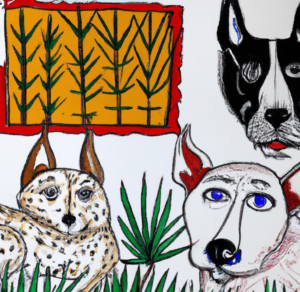
World Rabies Day: Navigating Beyond India’s Polarised Street Dog Debate
The growing street dog situation in India has sparked a variety of reactions from people, but often, we forget to consider the dogs’ point of view. These dogs find themselves in a catch-22; city life and accumulated waste offer food, but also bring them into potential conflict with humans.
Imagine you’re a street dog. The city is a survival challenge every day. As humans expand their territories, dogs must navigate this tricky landscape—grab the food from cities but also risk clashes with humans. Often, we misinterpret their responses—viewed as random attacks—as just them trying to protect themselves out of fear. Our inconsistent interactions with them, sometimes feeding, sometimes hostility, only add to their stress, making it harder for them to live peacefully among us.
As of 2018, the World Health Organisation (WHO) puts India’s street dog population at a massive 35 million. Despite these big numbers, these dogs simply need safety, food, and medical help when required. But the reality isn’t that simple. They face random violence and even mass extermination campaigns. For instance, the notorious 2015 culling in Kerala wiped out over 40,000 street dogs. This illustrates the pressing need for humane, science-backed solutions.
From our perspective, we worry about dog bites, diseases like rabies, and cleanliness. Rabies is almost always deadly once symptoms show, but it can be prevented with vaccination.
This is why the World Health Organization (WHO, 2019) suggests a complete strategy: remove rabies in dogs through vaccination, raise awareness about rabies and preventing dog bites, and immunize people. This aligns with the shift from eliminating ‘stray dogs’ to managing their numbers through anti-rabies vaccines and neutering (Taylor et al., 2017b; Cleaveland and Hampson, 2017).
In the heat of this growing problem, India’s Animal Birth Control (ABC) rules have been criticized for not doing enough. Detractors argue that the ABC program hasn’t reduced the street dog population or curbed dog bites. However, it’s important to note that the ABC rules aim to humanely and gradually control dog numbers through sterilization, not to prevent dog bites or set feeding rules. So, asking the ABC program to solve all human-dog issues is like trying to cure a symptom while ignoring the real problem.
The ABC rules, along with mass anti-rabies vaccination (ARV), are key parts of the puzzle and should be looked at in this wider context. While some people and even state governments call for culling dogs, studies from groups like the World Organisation for Animal Health (OIE) show that culling doesn’t reduce dog populations long-term or ease human-dog tensions.
Research on our attitudes towards dogs emphasizes the need for a shift in how we see and handle street dogs and their related issues. People’s feelings about street dogs in India are mixed, as shown by Srinivasan et al. (2019). About 37% of people surveyed had a more positive view of street dogs. This suggests that while some see dogs as a problem or health risk, many accept them as part of public spaces. This reflects the Tamil term ‘theru nai’ (street dog), hinting at dogs as a core part of society even if they aren’t owned by humans.
Interestingly, most people surveyed (71.6%) saw street dogs as a problem but also believed in their right to live on the streets. They recognized street dogs as city residents and vulnerable beings. These findings underscore the need for solutions that consider both human and dog wellbeing.
To do this, India should assess the success and limits of policies like ABC, encourage responsible feeding practices, and support scientific, humane strategies for population control and resolving conflicts. Moreover, educating the public about dog behavior can replace fear with understanding, reducing dog bite incidents.
The conversation about human-dog conflict in India needs to go beyond a black-and-white story to a more comprehensive discussion. This should include multiple viewpoints, such as those of the street dogs, the human communities they interact with, socio-economic differences, and cultural and historical contexts.
As we consider the way forward, we shouldn’t forget this profound truth: street dogs are as much a part of our cities as we are. They’ve thrived alongside us, adapted to city life, and found their place in our shared ecosystem. Our cities aren’t just for humans; they’re shared spaces where different forms of life cross paths and live together. Trying to isolate or kill off animals would disrupt our urban ecosystems and lessen the rich tapestry of our society.
Street dogs in India embody resilience, adaptability, and survival—traits that can teach us about our cities and their inhabitants. So, we need to foster an inclusive, compassionate, and scientifically-guided approach that favors coexistence over conflict. Our future actions should be guided by the belief that our cities are shared spaces—for humans and non-humans alike. By embracing this, we can create a city landscape defined not by conflict, but by unwavering dedication to harmony and mutual respect.






